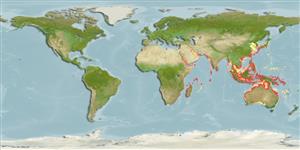>
Eupercaria/misc (Various families in series Eupercaria) >
Sillaginidae (Smelt-whitings)
Etymology: Sillago: From a locality in Australia .
Environment: milieu / climate zone / depth range / distribution range
Sinh thái học
Biển; Thuộc về nước lợ Cùng sống ở rạn san hô; sống cả ở nước ngọt và nuớc mặn (Ref. 51243); Mức độ sâu 0 - 60 m (Ref. 6205), usually 0 - 2 m (Ref. 90102). Tropical; 26°C - 29°C (Ref. 4959); 41°N - 36°S, 20°E - 166°E (Ref. 6205)
Indo-West Pacific: southern Red Sea (Ref. 94953) and Knysna, South Africa to Japan and south to Australia. Reported from New Caledonia (Ref. 9070). In Japan, this name has often been misapplied to Sillago japonica; often misidentified as Sillago lutea or Sillago vincenti.
Length at first maturity / Bộ gần gũi / Khối lượng (Trọng lượng) / Age
Maturity: Lm 16.7, range 13 - 19.1 cm
Max length : 31.0 cm SL con đực/không giới tính; (Ref. 44894); common length : 20.0 cm SL con đực/không giới tính; (Ref. 9679); Tuổi cực đại được báo cáo: 7 các năm (Ref. 43081)
Các tia vây lưng cứng (tổng cộng): 11 - 13; Các vây lưng mềm (tổng cộng): 20-23; Tia cứng vây hậu môn 2; Tia mềm vây hậu môn: 18 - 23. Swim bladder with two anterior and two posterior extensions. The anterior extensions extend forward and diverge to terminate on each side of the basioccipital above the auditory capsule. Two lateral extensions commence anteriorly, each sending a blind tubule anterolaterally and then extending along the abdominal wall below the investing peritoneum to just posterior of the duct-like process. Two posterior tapering extensions of the swim bladder project into the caudal region, one usually longer than the other. The species has a low lateral line with about 70 scales (Ref. 48635).
Common along beaches, sandbars, mangrove creeks and estuaries. Recorded from freshwater. Form schools. Adults bury themselves in the sand when disturbed (Ref. 6205, 44894). Feed mainly on polychaete worms, small prawns (Penaeus), shrimps and amphipods (Ref. 6226, 6227, 44894). Oviparous (Ref. 205). Larvae and juveniles are pelagic feeding on planktonic (Ref. 43081). Rarely captured by prawn trawling vessels. Marketed fresh and frozen (Ref. 9987).
McKay, R.J., 1992. FAO Species Catalogue. Vol. 14. Sillaginid fishes of the world (family Sillaginidae). An annotated and illustrated catalogue of the sillago, smelt or Indo-Pacific whiting species known to date. Rome: FAO. FAO Fish. Synop. 125(14):87p. (Ref. 6205)
IUCN Red List Status (Ref. 130435)
Threat to humans
Harmless
Human uses
Các nghề cá: Tính thương mại; Nuôi trồng thủy sản: Tính thương mại
Các công cụ
Special reports
Download XML
Các nguồn internet
Estimates based on models
Preferred temperature (Ref.
123201): 24.8 - 29.2, mean 28.5 °C (based on 3250 cells).
Phylogenetic diversity index (Ref.
82804): PD
50 = 0.5000 [Uniqueness, from 0.5 = low to 2.0 = high].
Bayesian length-weight: a=0.00589 (0.00492 - 0.00704), b=3.06 (3.01 - 3.11), in cm total length, based on LWR estimates for this species (Ref.
93245).
Mức dinh dưỡng (Ref.
69278): 3.3 ±0.1 se; based on diet studies.
Thích nghi nhanh (Ref.
120179): Chiêù cao, thời gian nhân đôi của chủng quần tối thiểu là dưới 15 tháng (K=0.75-1.22; tm=1; tmax=4; Fec=16,682).
Prior r = 0.79, 95% CL = 0.52 - 1.19, Based on 1 stock assessment.
Fishing Vulnerability (Ref.
59153): Low vulnerability (24 of 100).
Climate Vulnerability (Ref.
125649): Moderate vulnerability (43 of 100).
Nutrients (Ref.
124155): Calcium = 208 [37, 506] mg/100g; Iron = 0.719 [0.238, 1.909] mg/100g; Protein = 21 [18, 23] %; Omega3 = 0.0971 [, ] g/100g; Selenium = 31 [9, 139] μg/100g; VitaminA = 113 [19, 650] μg/100g; Zinc = 1.42 [0.69, 3.58] mg/100g (wet weight); based on
nutrient studies.
